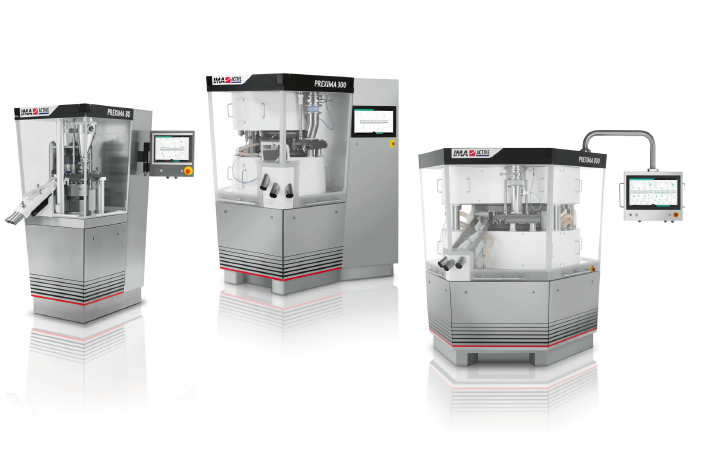
How to perform a good scale-up.
Federica Giatti, Compression Technologist at IMA Active Fabriano Ferrini, Product Manager for tablet presses at IMA Active |
Scale-up is the art of process designing using data obtained from the pilot plant model: in general, there isn’t an accurate prediction to perform properly scale-up but there are excellent methods that could help in understanding tablet-ability even in small than in large scale. Defined as an ongoing challenge, scale-up takes in consideration powder characteristics, tablet press design and tooling features: achieving good scale-up means consider it from the first product development.
Homogenous particle size distribution, proper flowability are an example of critical attributes that could affect a successfully transfer even if, in R&D level, blend works well. Once the formulation and its tabletability are well-defined thanks to preliminary R&D studies, first step is to start studying blend behavior in a lab pilot scale rotary press, able to perform also small industrial batch, in order to understand tableting parameters able to give desired results.
The first problem to face is the flow and automatic feeding inside tablet press: if the formulation does not segregate and flows properly, blend could be load in tablet-press with feeding system equipped with paddles, whose profile must be selected according to powder characteristics. This step could be very challenging in scale-up because it can limit output and tablet-ability of powder, changing sort of tableting process. For this reason, starting studying a formulation in a lab scale rotary press, completely equipped as an industrial one, could be the goal in a scale-up process.

According to tooling features, it is important take in consideration that equipment could be equipped with a mixed type punches turret: having, for example, the possibility to interchange in the same rotor B and D punches can give data about physical and chemical powder properties. Differences between B and D tooling are mainly due to dimension of flat head that is higher in D than in B format. This variance could really affect dwell time that will be longer in D type causing increasing in tablet’s hardness with same machine parameters.
According equipment configuration, deeply understanding the stages that occur during tablet production is the lynchpin of a good scale-up.
These steps include powder transport after blending towards tablet press, powder feeding in equipment, time of dies under feeding system, peripheral speed that is strictly connected to pitch circle diameter and turret speed, contact time, ejection force and rate and tablets take-off. Powder feeding considers, also, the flow from hopper to feeding system and from the feeding system to dies: if the formulation is not reproducible and stable, scale-up could fail. Time of dies under feeding system firmly depends on feed frame length and dosing cam setting that has to identically replicate the industrial scale.
Contact time is the most critical feature that has to be taken in consideration: it includes consolidation time, dwell time and decompression time. Consolidation time is the moment in which punches are changing their vertical position decreasing the distance between their tips, dwell time is the time in which punches achieve maximum penetration in the dies under roll: this means that the punches are no moving vertically and the head flat are completely in contact with roll. This time is one of the main topic that has to be considered in up-scaling because it influences the ability of powder to form liquid bonds that strictly depends on viscoelastic characteristics affecting final tablets strength.
Finally, decompression or relaxation time includes the movement of punches when they are increasing distance between tips before losing contact with rolls.
Ejection, in general, does not affect negatively in scale-up because movement of lower punch decreases the strain when pitch diameter increases. Considering the presence of several cell and software in support of understanding and prediction, scale-up could be easily evaluated.
Once tooling and formulation are optimized at their best in a pilot machine, product could be up-scaled in an industrial rotary press easily. First step is calculate peripheral speed (vp) and contact time (t) in order to be sure that even the loading in dies than speed of the machine are similar.
These equations can be used to find correct values:

R = pitch machine radius (mm)

R = pitch machine radius (mm)
α = angle defined by die inside feeding system (rad)
After they have been defined, set correctly the paddles speed, considering difference in diameter, is the final feature that complete a good scale-up.
To control that everything fit the quality required, pre-compression, compression and ejection force and relative standard deviations can be compared: if they are quite similar to ones get in lab scale rotary press, scale-up has been correctly performed.
In conclusion, scale-up of a tablet formulation consists in an accurate balance between development of the product and deep knowledge of the process.
Last Submitted Papers:
- Achieving and maintaining GAMP® 5 compliance: IMA Active’s risk-based approach to software development and verification
- Development of an automated multi-stage continuous reactive crystallization system with inline PATs for high viscosity process
- Prexima 300. Determination of the effect of the pre-compression force on the tablet hardness, obtained at constant value of the main compression force
- FMECA Risk Analysis background for calibrated containment solutions
- Fractional Fractorial Design
- Validation of Cleaning in Place
- Coating optimization: equipment features to prevent defects
- Drug layering: the impact of up-scaling
